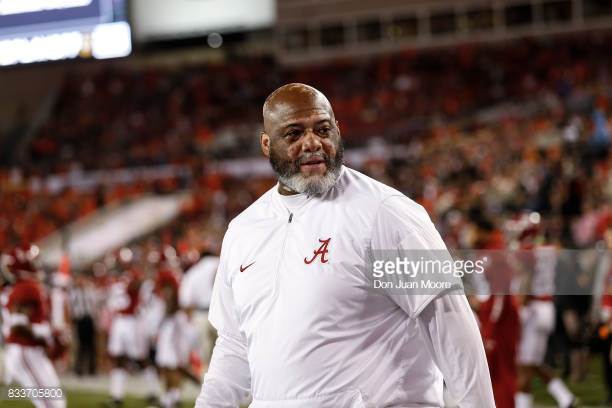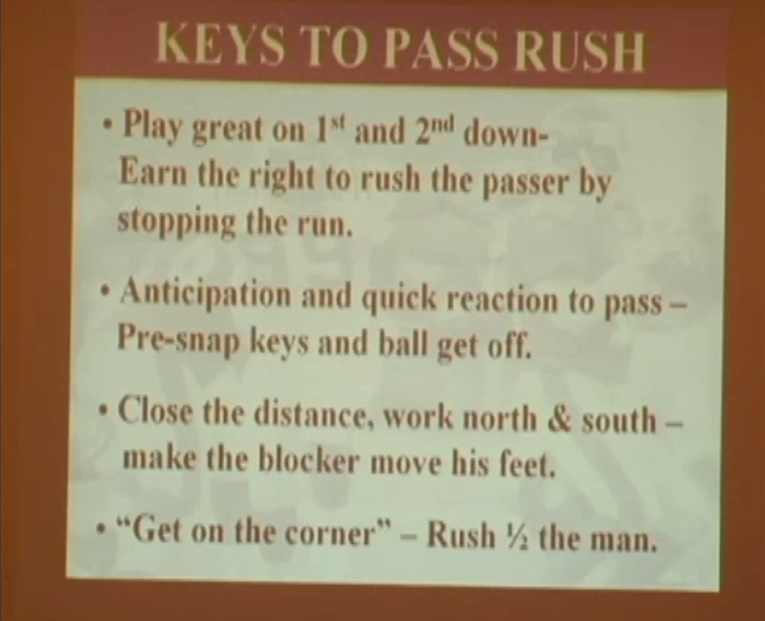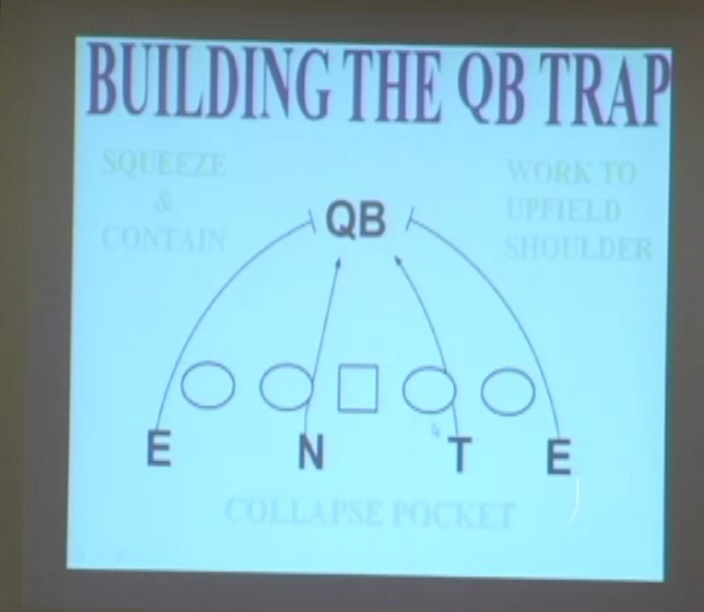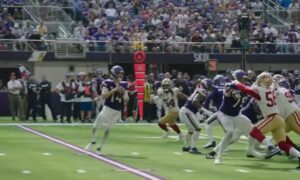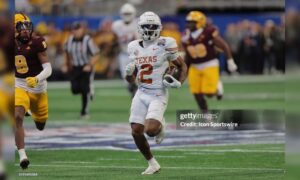Last week, we broke down a Karl Dunbar coaching clinic of how he teaches his defensive linemen against the run. And larger than that, got to know who he is as a coach. Today, we’ll do the same but break down his clinic – from the same event, for the record – of how he teaches his guys how to rush the passer.
Up front, I feel like this clinic was a little less helpful than the last one. Maybe that’s because it’s the second I watched and there’s overlap. But this one was more example-based and because Dunbar at the time was coaching a 4-3, it doesn’t translate quite as well to Pittsburgh. Still, there was lots of good information.
Again, we’ll start with some of the larger philosophies he presented throughout the 50 minute clinic. Dunbar has a clear philosophy that if you want to see it on the field, you have to drill and teach it.
“For every skill on the field, you should make up a drill.”
Later on, he reemphasized the point.
“If you don’t coach it, why do you think you’re going to get it?”
Though last time, he described himself as someone who doesn’t lose his cool and wants to be there for his players, his coaching revolves around one idea: accountability. He spoke that he has to hold his best players, at the time, Kevin Williams and Pat Williams, accountable. Because if he doesn’t, he loses the respect of the entire unit. And he routinely called them out if they didn’t do something correctly.
“There’s only one standard. And hold them accountable…If you do it wrong, I’m going to coach you up. That’s why they call me coach.”
An approach very much in-line with Mike Tomlin’s “standard is the standard” guiding principle.
Dunbar believes you don’t get to just be a pass rusher. That ability has to be earned.
“You have to earn the right to rush the passer. Because if you don’t stop them from running the ball, they won’t throw.”
He explained that it ties in with his philosophy to stopping the run, posing the question that if teams are going to gain four yards a pop on the ground, they have no reason to pass.
He summed up the run and pass game in this way. In the run game, the defensive line is looking to create space between he and the offensive linemen. But in the pass game, it’s the offensive linemen who is trying to create space and the DL trying to eat that cushion up. That way, the DL can get close enough to be able to shed the block.
Even with all the drills and time spent working with the DL, pass rushing still comes down to options, Dunbar explained. He can’t tell a defensive linemen what move to use on a particular play because it all depends on the linemen’s pass set. He summed up how to win a pass rush in this way.
“If a guy is retreating, you want to attack him. If a guy is attacking, you want to move and get around him.”
Dunbar, and any coach, is there just to give the pass rusher the proper tools in his toolbox. Then the player goes out and executes.
Like most coaches who deal with the pass rush, the goal is to contain the QB. Keep him in the pocket. The defensive ends rush outside and attack the upfield shoulder, forcing the QB to climb, while the interior line collapses and takes that away too.
Lots of film study to try to understand protections but Dunbar offered up one piece of valuable information. Often times, the center will slide away from the back to create a three man surface (three blockers) on each side.
As he did in the run game clinic, Dunbar talked a lot about the stance and ball key.
“Learn to roll off front hand and push off front foot for speed and lower body explosion” was one of his bullet points.
Most times, the linemen will align with his ball (inside) hand down. The interior linemen key the ball while the edge rushers read the outside knee of the tackle. You can see that read here, the knee being the first thing the tackle moves as he gets into his pass set.
During the week, Dunbar wants to create motivation and some competition among his group. Each week, they would pick out a “fish of the week,” that is, the opponent’s weakest offensive linemen that the DL expects to win against. And he wants to motivate his group to think they’re the best in the league.
“I make my guys believe we’re better going forward than they are going backward.”
He also made the analogy that the linemen are the refrigerators and the QB is the sweet meat. And every DL wants some sweet meat.
To him, all pass rushers have one common trait: good hips. And it’s something they work on too. His goal is for guys to be able to turn their hips while still getting vertical and gaining ground. Dunbar grabbed two coaches to give an idea of what he meant.
And showed some tape of it too. Watch #93 over left guard beat him cleanly.
He further explained it like this. Imagine a DL carrying a board between his legs. If he crosses his feet, he breaks the board. If hie feet get overextended, the board drops. Have to be able to open the hips and move the feet without dropping the board.
Dunbar ended the segment by talking about the importance of running to the football, just as he did in the run game. Guys are taught to turn and run and chase it. That starts in drills. He showed a cool clip of Dunbar and Mike Tomlin, when they spent 2006 together in Minnesota, working on this drill. Tomlin is the QB and shows off a pretty quick release (watch out, Landry Jones).
Here it is translating to Sundays.
Finally, he spent a lot of time talking about their stunts and games. There were three he mentioned by name.
EXIT – end goes first, then tackle
TEX – tackle first, then end
OTTO – nose tackle first, 3T second
Below, to the left of the screen is a “Tex” and on the right, an “Exit.”
And again, that all starts in drills, too. Steelers stunt plenty so this won’t be anything new. Just as Dick LeBeau did, Dunbar preached rush lane balance. Stunts always have to end up with two on each side to avoid creating a running lane and with someone responsible for at least one of the A gaps. Not going to have two rushers in the B gap and let the QB climb and take off.
Here’s a three man stunt.
One element he seemed to incorporate were some fake-out rushes and drops. Here’s an example of the 3T pretending to drop and then rushing free. Wonder if we’ll see some of that in Pittsburgh. Hasn’t happened before but I like the idea.
So there you go. Hopefully you’ve learned a lot about Dunbar’s philsophy. While his personality seems different than John Mitchell, it sounds like plenty of their core principles are the same.

